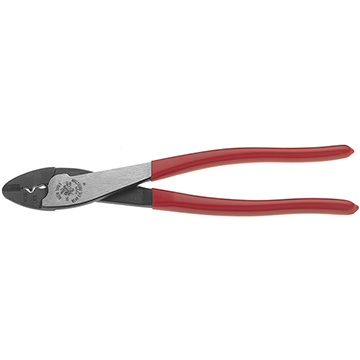Hilldweller
SE Expedition Society
I bought a bunch of them a long time ago at a gentler price.Crickey almost $0.80 each!:Wow1:
It might be nice to have a few in a repair kit but I don't think I'll be using them routinely anytime soon.
I bought a bunch of them a long time ago at a gentler price.Crickey almost $0.80 each!:Wow1:
It might be nice to have a few in a repair kit but I don't think I'll be using them routinely anytime soon.
The only time I use insulated terminals is for field repair. Otherwise I always use uninsulated and use adhesive lined heat shrink tubing. Using uninsulated lets me also visually inspect the connection after crimping. It also gives a less bulky connection.
I also put a dab of dielectric grease in the terminal for added protection.
x2 on using a quality crimper.
I use these Klein crimpers:
http://tinyurl.com/3ko732f

Crimp plus solder is the worst of both worlds IMHO.
I use Kliens as well but they take practice to use correctly. Most people are probably better off with the ratcheting type that won't release until the corret tension is reached.This is the secret to crimping is the proper tool. I prefer Klein #1006 myself over the #1005. I have challenged several people to pull my crimps apart with no success. Good crimpers like Klein and T&B have colored handels for a reason. There is a proper way the crimp goes in the crimper. Most all crimps are seemed, you want to position the seem of the crimp on the black handle side of the tool.
You really cant inspect the solder joint inside the crimp connector, at least with the Western Union splice you can see if you have a good solder joint.So I'm in the midst of a project, and just did this about a week ago. Why is it bad?
I'll likely have a nice little test bed of different techniques going in my truck. depending on the joint, I've soldered, crimped, tinned and crimped, and tinned, crimped then soldered.
To qualify my statements I'll preface them with this; I have over 25 years experience in electrical/electronics manufacturing.
When making connections with stranded wire a crimp connection is the only way that is reliable. It is well worth your time to learn to make a proper crimped connection as Martin described.
Here is the readers digest version of why a crimped connection is better;
We use stranded wire because it will bend many times without breaking as a solid wire would. As soon as you solder the strands together you introduce a potential point of failure due to metal fatigue.
Stranded wire is rarely soldered in a high rel applications such as military or space electronics, never in a wiring harness or connector. Way back in the 80's NASA and IPC did a boat load of studies on this which all came to the same conclusion.
